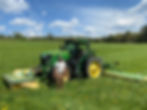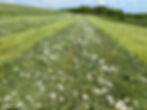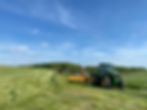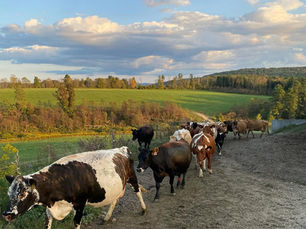Sustainable vs. Regenerative Agriculture
- mackenziehartung
- Aug 7
- 4 min read
When you want to make a conscious choice when shopping at the grocery store, you might see terms like “sustainable” or “regenerative” to describe a product. But is there a difference between the two? Are Maple Hill dairy farms sustainable or regenerative? We’ll dive into the nuances here to help you make a more informed choice.
What is Sustainable Agriculture?
What is Regenerative Agriculture?
Maple Hill’s Regenerative Approach

What is Sustainable Agriculture?
Sustainable agriculture is a method of farming that aims to protect the environment and ensure long-lasting viability. This might include things like crop rotation, reduced pesticide use, and efficient water management.
The practices that farmers use to ensure sustainability are not new — ancient techniques like composting and crop rotation were created to work with nature, not against it. Sustainability extends to animal welfare and the longevity and success of the farmers who manage the land.
In the U.S., there is a legal definition for sustainable agriculture which includes five key goals. Depending on the type of farm, whether they sustain crops or animals, sustainable farms must:
Produce enough food and fiber to meet the needs of consumers.
Take care of the environment by using sustainable practices that preserve natural resources like water and soil.
Use resources efficiently, such as water and energy, and rely on natural processes like composting and pest control to minimize waste.
Ensure that farming remains a profitable and sustainable livelihood for farmers and their families.
Contribute to a better quality of life for everyone by producing healthy food and supporting strong rural communities.
Conventional agriculture, also known as industrial farming, might vary from place to place. But it shares the singular goal of getting as much out of the land as possible for maximum profitability. Large-scale monocropping, the use of chemicals for pest and weed control, and the mass confinement of animals are all a part of conventional agriculture — with measurable consequences on the environment and for the animals involved.
Conventional agriculture frequently causes decline in soil productivity and an increase of pollutants. Pesticides have been detected in our groundwater and greenhouse gas emissions have increased with the use of synthetic fertilizers that emit nitrous oxide. The land, the animals, and even the health of the farmers themselves are at risk. Consider that over 400 insects and 70 fungal pathogens are resistant to one or more pesticides — chemicals that affect the entire ecosystem and its biodiversity.
Sustainable farming is the first step toward addressing these ills. These operations tend to be smaller in scale and put the land, animals, and people before profitability. It’s important to call out that there is an alternative to the destructive impact of conventional agriculture.


What is Regenerative Agriculture?
Regenerative agriculture goes a step beyond sustainability: it aims to restore and improve ecosystem health, leaving the land in a better place than it was before.
By restoring soil health, biodiversity, and water cycles, regenerative practices can help mitigate climate change, improve food security, and support farmer livelihoods. The key word is improvement: a sustainable farm is a good steward of the land, but a regenerative farm seeks to actively improve the soil health, water and air quality, biodiversity, and the nutrition found in the final product.
The core of regenerative agriculture is the care and restoration of soil health. When farmers improve soil health, they see consistent yields even during extreme weather changes. Soil resilience also means farmers don’t need to rely on inputs like fertilizers and other chemicals for management, and they use less fuel with practices like “no-till” that repair the soil.
When nature is in control, there is no monoculture or monocrop: biodiversity and an abundance of life returns to the land. Conventional farming, with its monoculture cash crops, leaves the land tilled and bare for most of the year. With no living roots, no protection against temperature and moisture, the soil degrades.
Dairy cows play a huge role in soil health and regenerative agriculture — when cows are not overcrowded and overgrazing, pastures have time to grow back and expand. Their hooves aerate the soil and contribute to the health of the land, while preventing topsoil loss. The relationship between grazing animals and ecosystems is broken in conventional farming, while the return of grazing animals is working to repair this unique balance.
Maple Hill’s Regenerative Approach
We're proud to be a leader in regenerative agriculture, working to restore and replenish the land across our milkshed. It’s a step beyond sustainability — each of our 135+ small family farms are actively working to reduce carbon, repair the soil, and restore biodiversity.
Our farmers use methods like rotational grazing to keep the land in balance, all without pesticides and synthetic fertilizer. The expanse of wild pasture also works to remove carbon from the atmosphere, which is just another way we are actively giving back to the environment. We also use cover crops to ensure that the soil holds moisture, which means that our farms require substantially less water. The healthy soil produces healthy grass, enhancing the health of the cows, which, in turn, produce the most nutrient dense dairy products on the market.
Maple Hill’s 100% grass-fed dairy cows are also working hard to regenerate pastures, provide soil nutrients with their waste, and continue the virtuous cycle that makes our way of farming so unique. Compared to the stress and diseases found in overcrowded conventional farms, our dairy cows live significantly longer and happier lives doing the thing they were built to do: graze and wander.
In short: Maple Hill practices sustainable farming, but also goes a step beyond to make sure we’re improving the land with a regenerative approach.
You can support our regenerative mission by purchasing our amazing dairy products in stores across the U.S. If you’d like to read more about what makes Maple Hill dairies regenerative and sustainable, check out:






